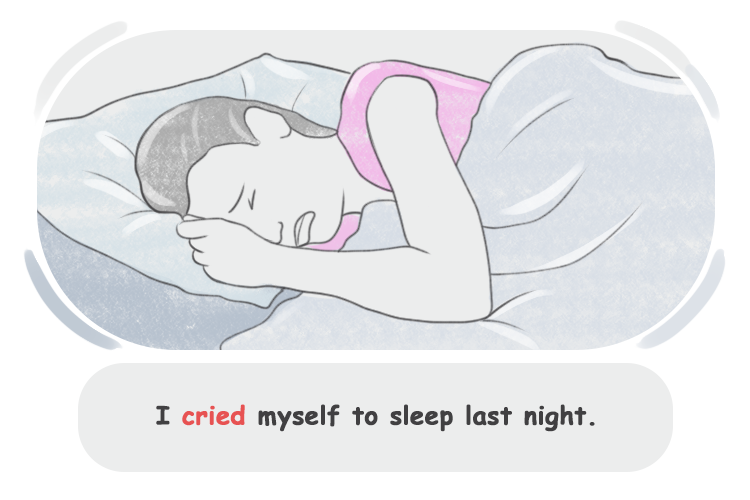Reflexive Verbs
Dive into reflexive verbs like 'enjoy yourself'. Detailed explanations and a quiz to test your knowledge.

What Are Reflexive Verbs?
Some verbs only take reflexive pronouns as their direct object or convey a unique meaning when used with these pronouns. These verbs are called reflexive verbs.
Reflexive Verbs: Types
Reflexive verbs can be categorized into three types:
Verbs that only allow a reflexive pronoun
Verbs that express an idiomatic meaning when used with reflexive pronouns
Verbs that use reflexive pronouns to express a result
Verbs That Only Allow a Reflexive Pronoun
The following is a list of verbs in English that always take a reflexive object. Most of these verbs are formal or literary.
Perjure
Pride
Absent
Avail (of)
Comport
Ingratiate
Express (the only possible human object is reflexive)
Check out the examples:
She absented herself from the meeting.
They availed themselves of the opportunity.
He prides himself on his work.
Reflexive Verbs with Idiomatic Meaning
Some verbs can be used with both reflexive and non-reflexive objects, but they express an idiomatic meaning when used with reflexive pronouns which is different from their meaning when used with non-reflexive objects. Examples of such verbs include:
help oneself → to serve or take something for oneself
find oneself → to be in a particular place or condition
enjoy oneself → to have fun in a particular activity or situation
behave/conduct/demean/acquit oneself → to act in a proper or appropriate way
suit oneself → to do whatever one wants
apply oneself → to focus or dedicate oneself to a task or goal
see oneself → to imagine or visualize oneself in a particular situation or place
distinguish oneself → to make oneself stand out or be recognized
prove oneself → to show one's ability or worth
content oneself → to accept something that is less that ideal
excel oneself → to do something better than one usually does
exert oneself → to make a big physical or mental effort
explain oneself → to offer justification for one's behavior
Here are some examples of using these verbs in sentences:
She contented herself with a small meal.
If you apply yourself, you can pass the exam easily.
He exerted himself to finish the marathon despite the heat.
Reflexive Verbs Expressing a Result
This group consists of verbs that are essentially intransitive or cannot have a human object. However, they take a reflexive pronoun together with an object complement to express a result of the action of the verb. These are often expressive, emotional, or metaphorical verbs, such as:
Cry
Laugh
Drink
Eat
Talk
Work
Scare
I cried myself to sleep last night.
Here, "to sleep" is the result predicative.
He drank himself sick at the party.
Are you trying to work yourself to death?


Reflexive Indirect Objects and Objects of Preposition
Sometimes, the reflexive pronoun is not the direct object of the verb, but its indirect object, or an object of preposition. In these cases too, the reflexive construction expresses an idiomatic or unique meaning that can only be expressed reflexively. For example:
He didn't give himself time to grieve.
Here, "himself" is the indirect object of the verb "give."
They told themselves it would be okay.
This expression means they reassured or tried to convince themselves.
He tends to keep to himself at parties.
"keep to oneself" means to avoid sharing thoughts or mixing with others
She was beside herself with joy when she heard the news.
"be beside oneself" means to be overcome by some emotion.
Tip!
Some sources consider any verb that can take a reflexive pronoun as object a reflexive verb. Many English verbs can take reflexive verbs without a change in meaning. Although grammatically correct, this is a property of reflexive pronouns, not the specific verb.
He was talking to himself.
This sentence is not any different from "He was talking to his friend."
They introduced themselves to the villagers.
You can also say "They introduced their friend to the villagers."
Review
Reflexive verbs take reflexive pronouns as their only possible object, or take reflexive pronouns as the object to express an idiomatic meaning or a result of the action of the verb on the subject. Reflexive verbs can take reflexive pronouns as direct objects, indirect objects, and objects of preposition. Here are some examples"
The witness perjured herself during the trial by denying what she had earlier confessed.
He finds it hard to express himself in front of large groups.
Express can take non-reflexive objects, but the only human object it allows is a reflexive pronoun.
Please help yourself to some cookies.
She scared herself silly watching that horror movie alone.
Quiz:
Which sentence contains a reflexive verb that only allows a reflexive pronoun?
She enjoyed herself at the concert.
He prides himself on his punctuality.
They helped themselves to seconds.
I found myself lost in thought.
Match each sentence to the correct meaning of the reflexive verb.
Which sentence correctly shows a reflexive verb expressing a result?
He found himself a new apartment downtown.
I saw myself winning the race.
They helped themselves to the pizza.
She laughed herself hoarse after hearing the joke.
Which sentence contains a reflexive pronoun used as the object of a preposition?
She taught herself to paint.
We congratulated ourselves after the win.
She only thinks of herself.
I reminded myself of the appointment.
Choose True or False for each sentence.
The verb "help" always requires a reflexive pronoun and cannot be used with other objects. | |
The verb "express" can have any human object, reflexive or not, without changing its meaning. | |
Some reflexive verbs can take reflexive pronouns as indirect objects instead of direct objects. | |
Verbs like "cry" and "laugh" become reflexive when they express the result of the subject's action. | |
It is grammatically correct for some English verbs to take a reflexive pronoun even if it does not change the meaning. |
Comments
(0)